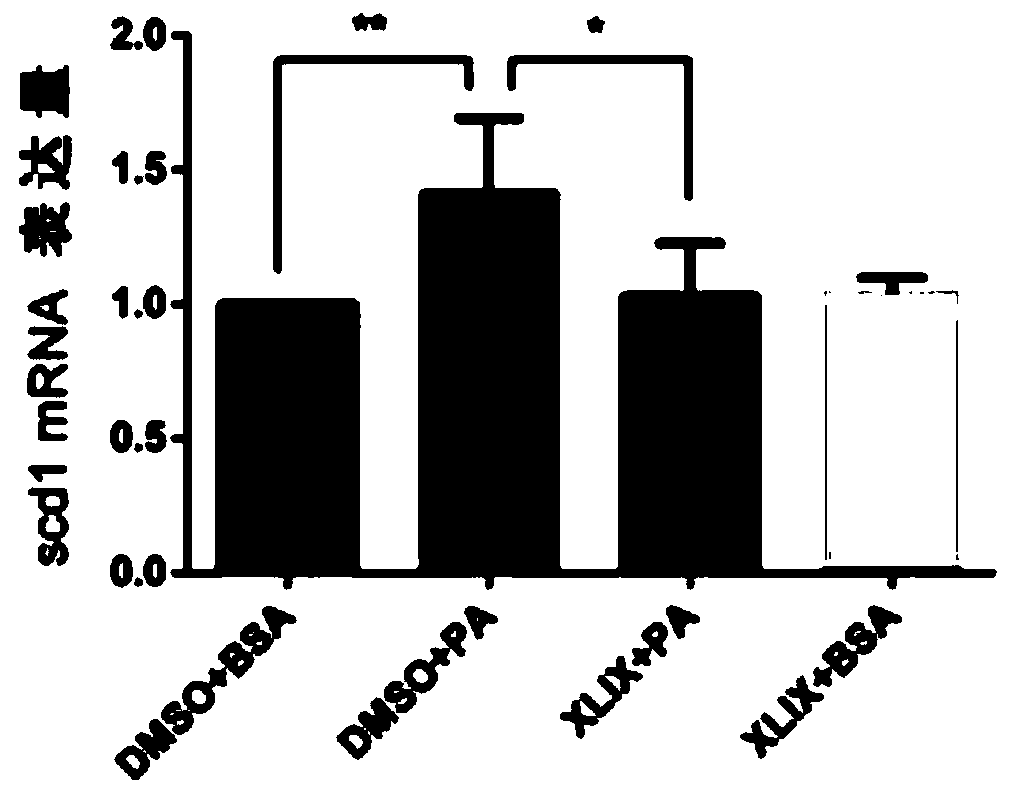Application of gypenoside-XLIX to preparation of medicine for improving liver fat metabolism
A technology of gypenoside and fat metabolism, which is applied in the field of biomedicine to achieve the effects of reducing content, improving liver fat metabolism disorders, and reducing fat accumulation
- Summary
- Abstract
- Description
- Claims
- Application Information
AI Technical Summary
Problems solved by technology
Method used
Image
Examples
Embodiment 1
[0036] Example 1 Establishment and Treatment of Nonalcoholic Fatty Liver Cell Model
[0037] At present, animal models are often used in the research of non-alcoholic fatty liver disease (NAFLD), but animal models have unfavorable factors such as large individual differences, many influencing factors, and difficult control of experimental conditions, while cell models can better overcome the above factors , to study the cellular mechanism of non-alcoholic fatty liver disease (NAFLD) in a targeted manner, and can further shorten the process of drug intervention, so in scientific research practice, especially in the screening of therapeutic drugs for non-alcoholic fatty liver disease (NAFLD) On the one hand, cell models have been paid more and more attention to and applied by researchers, providing a new promising option for the prevention and treatment of nonalcoholic fatty liver disease (NAFLD).
[0038] Hepatocytes are cells with a high degree of differentiation. Once they lo...
Embodiment 2
[0047] Example 2 Effect of Gypenoside XLIX on Hepatocyte TG Content
[0048] According to the instructions provided by the triglyceride (TG) kit, first collect the cells, add the lysate, shake and lyse, place on ice for 10 minutes, take out an appropriate amount of liquid to measure the protein concentration (BCA method), and heat the remaining liquid at 70°C 10 minutes, then centrifuge at 2000 rpm for 5 minutes at room temperature, take the supernatant and measure the TG content by the glycerol-3-phosphate oxidase method: add the sample according to the reagent instructions, mix well, react at 37°C for 10 minutes, adjust the blank tube to zero, and then measure The optical density (OD) value of each tube was used to draw a standard curve and calculate the TG concentration. Finally, the total protein concentration was used to correct the TG content. The obtained test results were as follows: figure 1 shown.
[0049] Depend on figure 1 The results showed that compared with th...
Embodiment 3
[0050] Example 3 Effect of Gypenoside XLIX on Fat Accumulation in Hepatocytes
[0051] Effect of Gypenoside XLIX on Fat Accumulation in Hepatocytes Using Oil Red O Staining
[0052] Preparation of oil red O working solution: oil red O was dissolved in isopropanol to prepare 0.5% oil red O stock solution, mixed the stock solution with distilled water at a ratio of 6:4 and filtered twice until the liquid was clear to obtain oil red O working fluid.
[0053] The mouse liver primary cells were inoculated into 12-well plates, and after incubation for 24 hours, they were divided into plates and treated according to the above method, and were divided into DMSO+BSA group, DMSO+PA group, XLIX+BSA group, XLIX+PA group, each group Add the corresponding treatment, the added medium is the same as the above, continue to incubate for 24 hours, remove the culture medium, stain the cells of each group with Oil Red O working solution for 30 minutes, wash with distilled water twice, observe the...
PUM
 Login to View More
Login to View More Abstract
Description
Claims
Application Information
 Login to View More
Login to View More - R&D
- Intellectual Property
- Life Sciences
- Materials
- Tech Scout
- Unparalleled Data Quality
- Higher Quality Content
- 60% Fewer Hallucinations
Browse by: Latest US Patents, China's latest patents, Technical Efficacy Thesaurus, Application Domain, Technology Topic, Popular Technical Reports.
© 2025 PatSnap. All rights reserved.Legal|Privacy policy|Modern Slavery Act Transparency Statement|Sitemap|About US| Contact US: help@patsnap.com



